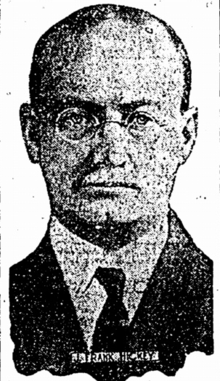J. Frank Hickey
John Frank Hickey (October 29, 1865 - May 8, 1922) was an American child molester and serial killer. Due to the postcards he mailed to the police and media, he was dubbed The Postcard Killer.[2]
J. Frank Hickey | |
|---|---|
 Mugshot of Hickey | |
| Born | John Frank Hickey 29 October 1865 Lowell, Massachusetts, U.S. |
| Died | 8 May 1922 (aged 56) Auburn State Prison, Auburn, New York, U.S. |
| Other names | The Postcard Killer |
| Details | |
| Victims | 3[1] |
Span of crimes | 1883–1911 |
| Country | United States |
| State(s) | Massachusetts, New York |
Date apprehended | 1912 |
Early life
John Frank Hickey was born in Lowell, Massachusetts, to Irish immigrants Michael J. Hickey and Mary Ann Magrath.[3]:12 He was baptized Roman Catholic at St. Patrick's Church, which was only two blocks from his parents' lodgings.[3]:12 After his arrest for murder in 1912, Hickey claimed to have been physically abused by his father.[3]:13–14
In his early teens, Hickey joined Lowell's First Congregational Church on Kirk Street.[3]:16 He also became an official of the Lowell YMCA and the Christian Endeavor.
First murder
On September 1, 1883, 18-year-old Hickey contacted police and said that he had found 34-year-old pharmacist Edwin W. Morey dead on the floor of the McGibbon's Drugstore, where both had worked. Hickey claimed that Morey had been despondent for some time due to alcoholism and that he had been trying to help his co-worker regain sobriety. As the doctor believed that Morey had taken poison, a stomach pump was brought. At midnight, Morey showed some signs of life, but died shortly after three o'clock in the morning.[3]:14–15
Years later, Hickey admitted to having murdered Morey with laudanum. He had been afraid that if their employer had found Morey intoxicated, he might fire them both.[3]:16–17
Freemasonry
Listing his occupation as "Secretary of the YMCA", Hickey applied for and received membership in Lowell's William North Masonic Lodge in 1887.[3]:16 In 1889, he became a Master Mason.[3]:17 Despite his later claims,[3]:30 Hickey never attained the rank of 32nd degree Freemason.[3]:17 Although his biographer Vance McLaughlin describes Hickey as having "quit the Masons in June 1895",[3]:184 Masonic records tell a different story. In March 1895, Hickey was arrested in Lowell for stealing 20 gallons of alcohol from his employer. In response, the Grand Lodge of Massachusetts ruled Hickey "a liar and profane" and expelled him "from all the rights and privileges of Freemasonry" on June 12, 1895.[4]
Second murder
In 1896 Hickey left Lowell and would never live there again.[3]:184 Between then and 1902, he drifted around Canada and the Northeastern United States, working various industrial jobs.[3]:184–185
On December 10, 1902, Hickey encountered Michael R. Kruck, an eleven-year-old newspaper vendor. When Kruck offered to sell him a newspaper, Hickey responded that he would purchase all of them if the boy would follow him into Central Park. When Kruck did so, Hickey strangled him and left his body with the newspaper bundle under his head.[3]:50–51 The coroner later examined the body and found no evidence of sexual assault. The coroner's inquest ruled that Michael R. Kruck met his death by being strangled "by some person or persons unknown to this jury."[5][3]:50 On December 12, 1902, Michael Kruck's body was released from the morgue and buried at Brooklyn's Washington Jewish Cemetery.
Third murder
On October 12, 1911, Hickey, then employed as a steel plant supervisor in Lackawanna, New York, noticed seven-year-old Joey Joseph playing at his father's men's furnishing store.[3]:7 Later, when Joey was making mud puddles with a friend in the street near his house, Hickey motioned to them to join him. He gave Joey a few pennies to buy candy for himself and his friend. Upon Joey's return, Hickey abruptly told his friend that it was time for him to go home.[3]:7
Hickey then took Joey by the hand and led him to an outhouse behind a saloon on Ridge Road. There Hickey strangled Joey into unconsciousness, sexually molested him, and then strangled him to death. Hickey then dumped the boy's body into the outhouse pit.[3]:8
Postcards
Despite the assistance of the Buffalo Police Department, the investigation into Joey Joseph's disappearance had almost no leads.[3]:8–11 Then, on October 30, 1911, a postcard was delivered to Lackawanna police chief Gilson. It read, "Joseph Joseph will be found in the bottom of a water closet with three seats, back of the saloon near Doyles, on Ridge Road. A drunk crazed brain done the deed, and remorse and sorrow for the parents is bringing results that will soon come to an end. The demon whisky will then have one more victim, making four in all. Drag the closet with the three seats."[3]:19–20[6]
References
- The Cornell Daily Sun. November 30, 1912
- The Postcard Killers ISBN 978-0-099-55375-5 p. 98
- McLaughlin, Vance. The Postcard Killer: The True Story of America's First Profiled Serial Killer and How the Police Brought Him Down, Thunder's Mouth Press, New York, 2006.
- "Proceedings of the Most Worshipful Grand Lodge of Ancient Free And Accepted Masons in the Commonwealth of Massachusetts" 1895, pp.121–22.
- "Newsboy Murdered in Central Park; Little Fellow was Strangled, Presumably with Knotted Cord. Queer Wound on Cheek Puzzles Coroner's Physician- No Clue to Perpetrator of Crime", New York Times, December 12, 1902. Pagw 16.
- Postcards from Murderer which Led to Discovery of Joseph Child's Body, Buffalo Evening News, November 16, 1912. Page 1.
Cited works and further reading
- Lane, Brian (1995) [1993]. Chronicle of 20th Century Murder. Wiltshire: Select Editions. ISBN 978-0-425-14649-1.
- McLaughlin, Vance (2006). The Postcard Killer: The True Story of J. Frank Hickey. Pennsylvania: Running Press. ISBN 978-1-560-25909-1.